Table of Contents
- Introduction
- Editor’s Choice
- Meal Kit Delivery Services Market Overview
- Global Meal Kit Users Statistics
- Meal Kit Delivery Market Overview
- Revenue Generation Through Meat-Kit Delivery Services Statistics
- Ordering Preferences of Meat Kits Online – By Country
- Consumer Preferences and Trends
- Impact of COVID-19
- Advantages and Benefits
- Issues and Challenges
- Regulations for Meal Kit Delivery Services
- Recent Developments
- Conclusion
- FAQs
Introduction
Meal Kit Delivery Services Statistics: Meal kit delivery services simplify home cooking by delivering pre-portioned ingredients and detailed recipes directly to customers’ doorsteps on a subscription basis.
These services offer a wide variety of meal options, including vegetarian, vegan, and gluten-free choices, catering to diverse dietary preferences.
Ingredients are typically fresh and often sourced locally or organically. Despite generally being more expensive per meal compared to grocery shopping. Meal kits provide convenience by eliminating the need for shopping and meal planning.
The industry is competitive, with leaders distinguishing themselves through menu variety, pricing strategies, and sustainability efforts. Reflecting a growing consumer preference for convenient yet quality meal solutions.
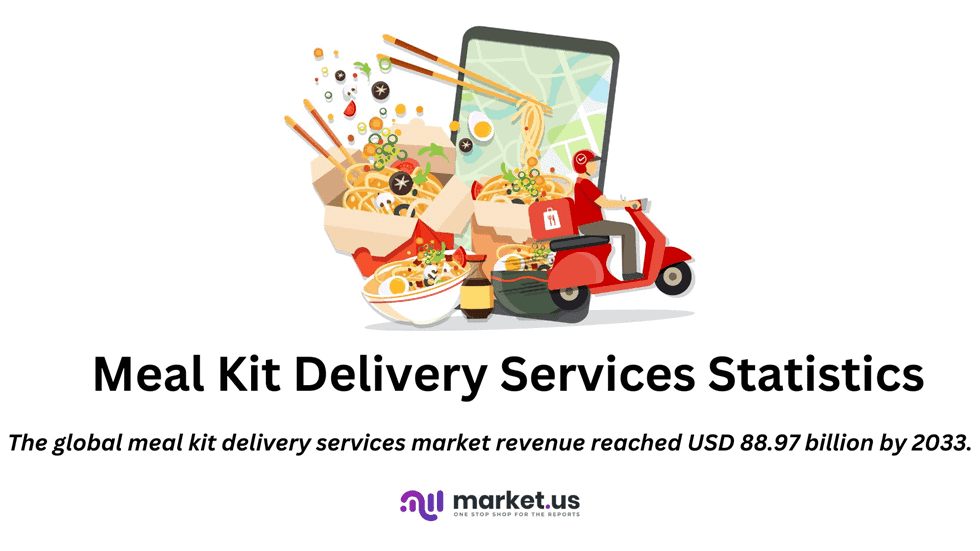
Editor’s Choice
- The global meal kit delivery services market revenue reached USD 88.97 billion by 2033.
- The growth trajectory continues with expected revenues of USD 47.80 billion in 2029, USD 55.84 billion in 2030, USD 65.22 billion in 2031, USD 76.17 billion in 2032, and USD 88.97 billion in 2033.
- A significant disparity in market share between single and multiple service offerings characterizes the global meal kit delivery services market. Single-service offerings dominate the market, accounting for 58.60% of the total market share.
- In the global meal kit delivery services market, the distribution of market share by platform reveals a strong preference for online platforms. Online platforms command a substantial 64.10% of the market share. Indicating a significant consumer inclination towards digital channels for meal kit purchases.
- The global meal kit delivery services market is characterized by a diverse range of key players. Each contributes to the overall market dynamics. Blue Apron, LLC leads the market with a 12% share.
- The global meal kit delivery services market is geographically segmented. North America leading the market with a dominant 47.3% share.
- In March 2020, the expected changes in spending on meal kit delivery services in the United States due to the coronavirus pandemic revealed varied consumer expectations. A majority of respondents, 62%, anticipated no change in their spending on meal kit delivery services.
Meal Kit Delivery Services Market Overview
Global Meal-Kit Delivery Services Market Size Statistics
- The global meal kit delivery services market has exhibited robust growth at a CAGR of 16.8%. With revenue rising from USD 16.12 billion in 2022 to an anticipated USD 88.97 billion by 2033.
- In 2023, the market revenue reached USD 18.83 billion, followed by USD 21.99 billion in 2024.
- Projections for subsequent years show a steady increase. With revenues expected to climb to USD 25.69 billion in 2025 and USD 30.00 billion in 2026.
- The upward trajectory continues with forecasts of USD 35.04 billion in 2027 and USD 40.93 billion in 2028.
- By 2029, the market is anticipated to generate USD 47.80 billion, escalating further to USD 55.84 billion in 2030.
- The revenue is projected to reach USD 65.22 billion by 2031, USD 76.17 billion in 2032, and culminate at USD 88.97 billion by 2033.
- This consistent growth underscores the increasing consumer demand and expanding market reach of meal kit delivery services worldwide.
(Source: market.us)
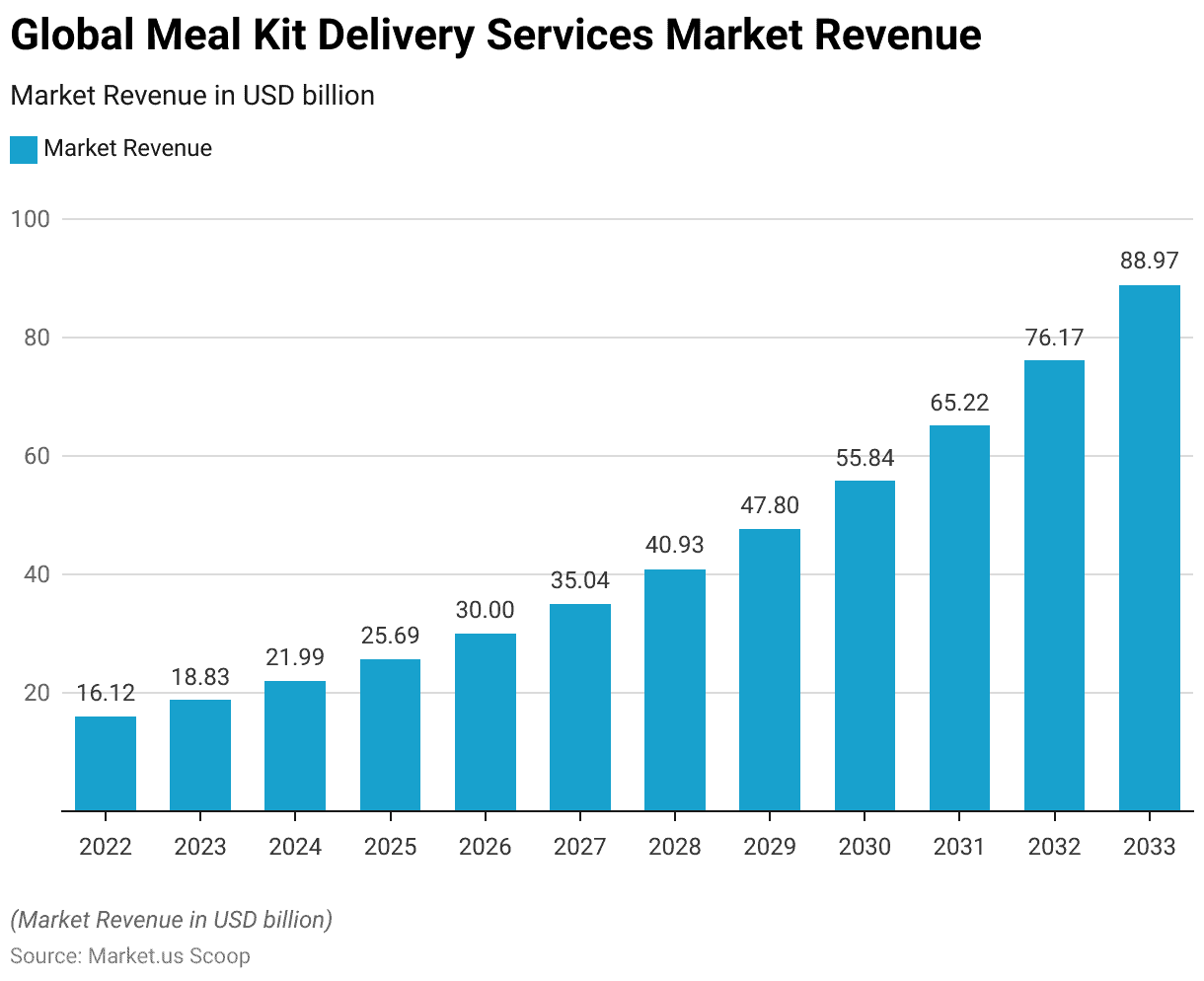
Meal-Kit Delivery Services Market Size – By Offering Statistics
2022-2025
- The global meal kit delivery services market, segmented by offering, has shown substantial growth from 2022 to 2033.
- In 2022, the total market revenue was USD 16.12 billion, with “Cook & Eat” services contributing USD 9.90 billion and “Heat & Eat” services accounting for USD 6.22 billion.
- By 2023, the market revenue increased to USD 18.83 billion. Comprising USD 11.56 billion from “Cook & Eat” and USD 7.27 billion from “Heat & Eat.”
- This upward trend continued in 2024, with total revenue reaching USD 21.99 billion, of which USD 13.50 billion came from “Cook & Eat” and USD 8.49 billion from “Heat & Eat.”
- Projections for 2025 indicate a total market revenue of USD 25.69 billion. With USD 15.77 billion from “Cook & Eat” and USD 9.92 billion from “Heat & Eat.”
2026-2033
- The market is expected to grow further, with revenues of USD 30.00 billion in 2026 (USD 18.42 billion from “Cook & Eat” and USD 11.58 billion from “Heat & Eat”) and USD 35.04 billion in 2027 (USD 21.51 billion from “Cook & Eat” and USD 13.53 billion from “Heat & Eat”).
- By 2028, the market is anticipated to reach USD 40.93 billion. With USD 25.13 billion from “Cook & Eat” and USD 15.80 billion from “Heat & Eat.”
- The growth trajectory continues with expected revenues of USD 47.80 billion in 2029, USD 55.84 billion in 2030, USD 65.22 billion in 2031, USD 76.17 billion in 2032, and USD 88.97 billion in 2033.
- Throughout this period, “Cook & Eat” services are projected to dominate the market. Contributing significantly to the overall revenue alongside the growing “Heat & Eat” segment.
(Source: market.us)
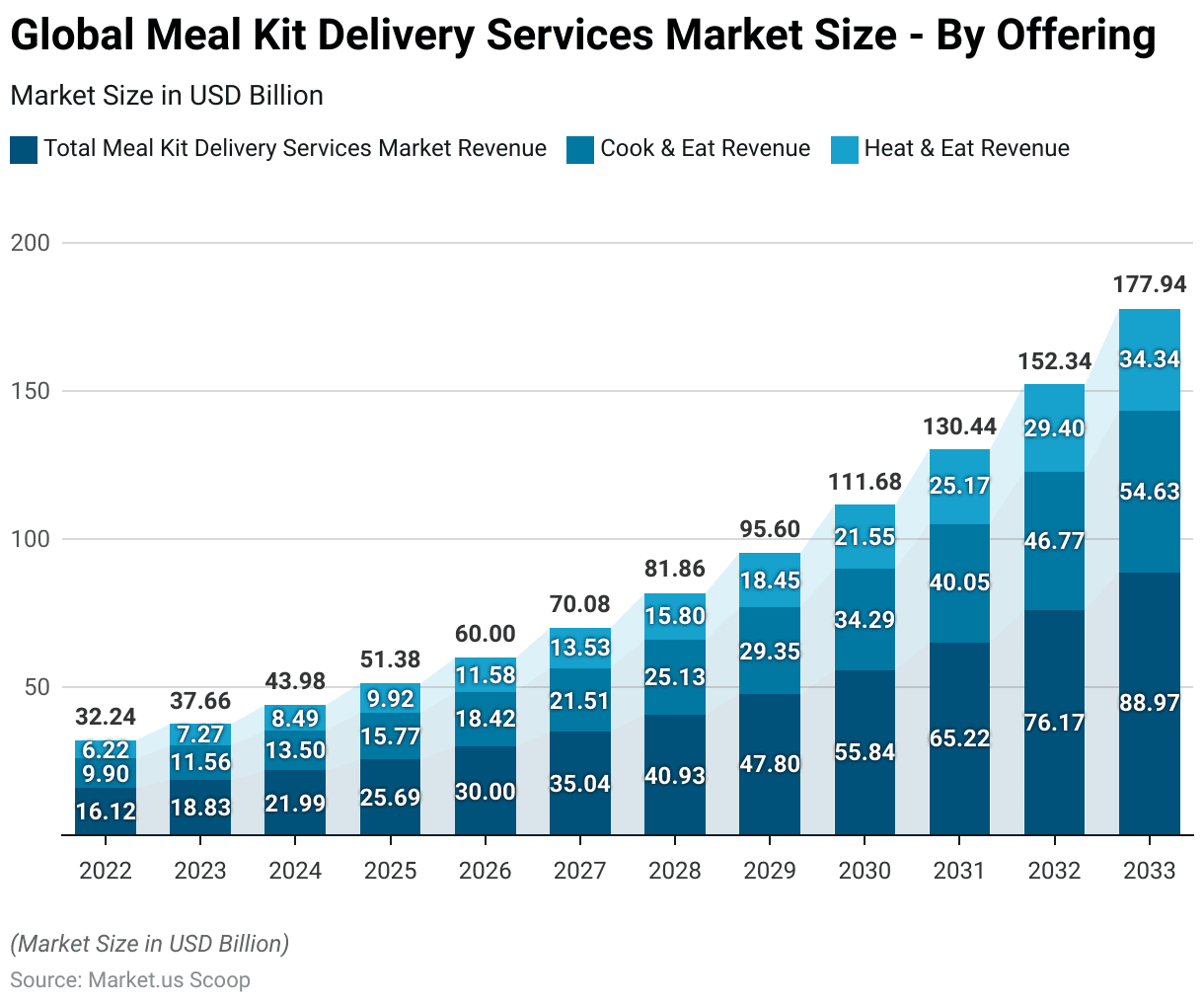
Global Meal-Kit Delivery Services Market Share – By Service Statistics
- A significant disparity in market share between single and multiple service offerings characterizes the global meal kit delivery services market.
- Single-service offerings dominate the market, accounting for 58.60% of the total market share.
- In contrast, multiple service offerings hold a smaller yet substantial portion, comprising 41.40% of the market share.
- This distribution highlights a consumer preference for single-service meal kits. Though multiple service options still represent a significant and growing segment within the industry.
(Source: market.us)
Take advantage of our unbeatable offer - buy now!

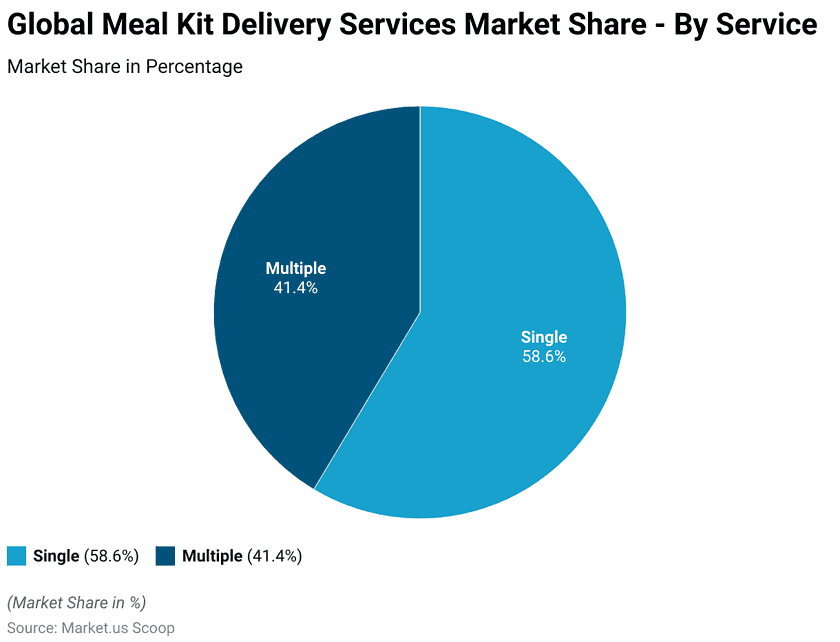
Global Meal-Kit Delivery Services Market Share – By Platform Statistics
- In the global meal kit delivery services market, the distribution of market share by platform reveals a strong preference for online platforms.
- Online platforms command a substantial 64.10% of the market share, indicating a significant consumer inclination towards digital channels for meal kit purchases.
- In contrast, offline platforms account for 35.90% of the market share.
- This distribution underscores the increasing reliance on online services for convenience and accessibility while offline platforms continue to maintain a considerable presence in the market.
(Source: market.us)
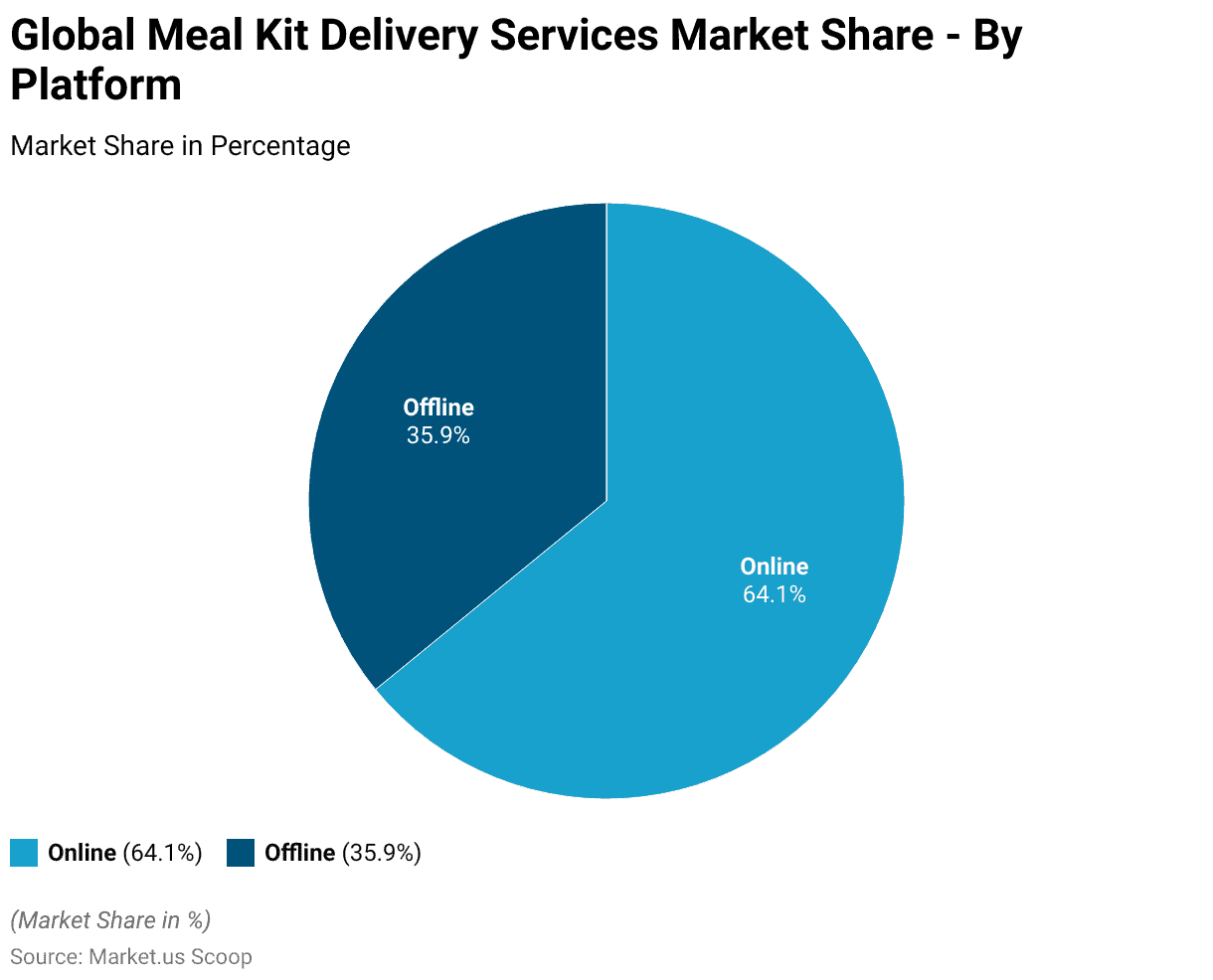
Competitive Landscape of Global Meal-Kit Delivery Services Market Statistics
- The global meal kit delivery services market is characterized by a diverse range of key players, each contributing to the overall market dynamics.
- Blue Apron, LLC leads the market with a 12% share, followed closely by Freshly Inc. and HelloFresh, each holding an 11% share.
- Sun Basket also commands an 11% market share, indicating a competitive landscape among the top companies.
- Relish Labs LLC and Gobble each capture 10% of the market, while Marley Spoon Inc. holds a 9% share.
- Purple Carrot and Fresh n’ Lean account for 8% and 7% of the market, respectively.
- Hungryroot contributes 6% to the market share, with other key players collectively comprising the remaining 5%.
- This distribution highlights a competitive market with several major players vying for significant portions of the market.
(Source: market.us)
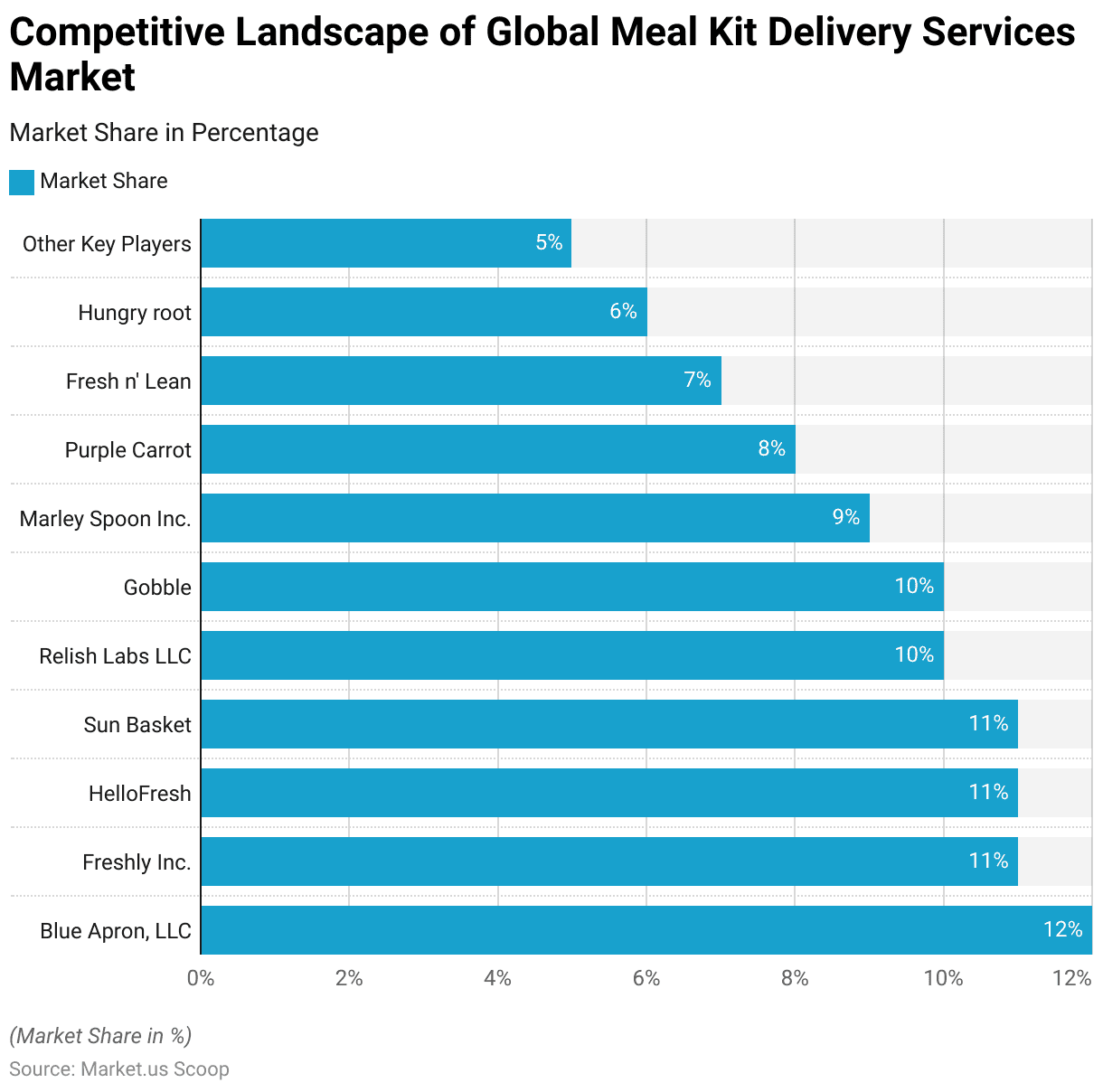
Regional Analysis of Global Meal-Kit Delivery Services Market Statistics
- The global meal kit delivery services market is geographically segmented, with North America leading the market with a dominant 47.3% share.
- This is followed by the Asia-Pacific (APAC) region, which holds a substantial 26.3% share, reflecting significant growth and adoption in this area.
- Europe accounts for 19.0% of the market share, indicating a strong presence in the region.
- South America and the Middle East & Africa (MEA) contribute smaller shares, at 5.0% and 2.4% respectively.
- This regional distribution highlights the varying levels of market penetration and consumer adoption across different parts of the world, with North America and APAC emerging as key regions in the meal kit delivery services market.
(Source: market.us)
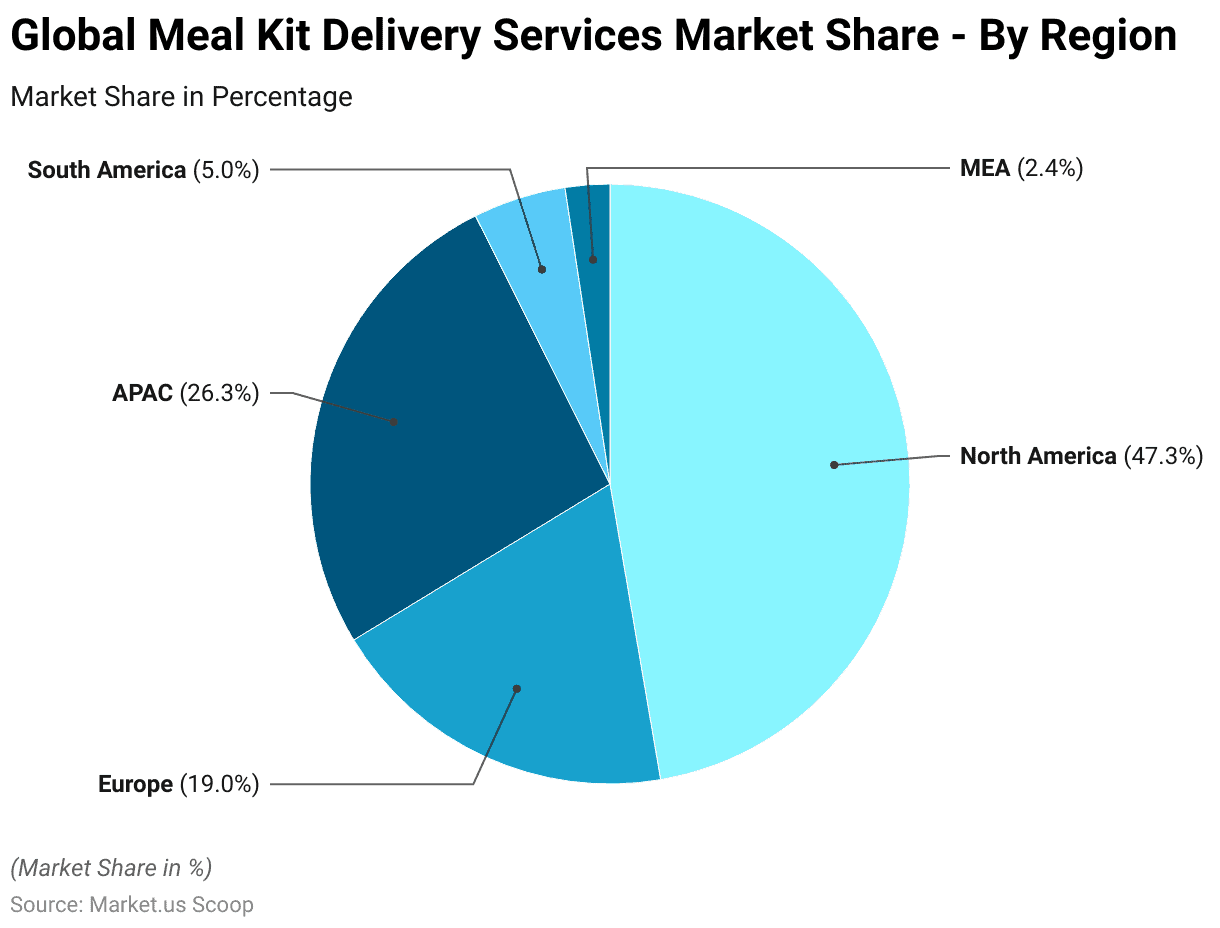
Global Meal Kit Users Statistics
Number of Meal Kit Users Worldwide and Penetration Rate
- The global meal kit delivery market has shown a steady increase in the number of users and a gradual rise in market penetration rates over the years.
- In 2017, there were 9.4 million users worldwide, corresponding to a penetration rate of 0.1%. This number grew to 10.7 million users in 2018 and 12.2 million in 2019, with the penetration rate remaining at 0.1% initially but increasing to 0.2% by 2019.
- The growth accelerated in 2020, reaching 16.5 million users and a penetration rate of 0.2%.
- By 2021, the user base expanded to 19.8 million, with the penetration rate climbing to 0.3%. This upward trend continued, with 21.4 million users in 2022 and 20.8 million in 2023, maintaining a penetration rate of 0.3%.
- Projections for the following years show a consistent increase in users: 21.2 million in 2024, 22.2 million in 2025, 23.3 million in 2026, 24.1 million in 2027, 24.6 million in 2028, and reaching 25.0 million by 2029, with the penetration rate stabilizing at 0.3%.
- This data indicates a growing acceptance and adoption of meal kit delivery services worldwide, with a consistent penetration rate reflecting sustained market engagement.
(Source: Statista)

Meal Kit Delivery Market Overview
Global Meal-Kit Delivery Services Market Revenue Statistics
- The global meal kit delivery market has experienced substantial revenue growth from 2017 to 2029 at a CAGR of 4.57%.
- In 2017, the market generated USD 4.34 billion, which increased to USD 5.11 billion in 2018 and USD 6.14 billion in 2019.
- A significant surge occurred in 2020, with revenues reaching USD 8.81 billion, driven by the increased demand during the global pandemic.
- This upward trend continued in 2021, with revenues of USD 11.16 billion and further growth in 2022 to USD 12.61 billion.
- In 2023, the market saw a slight increase to USD 12.69 billion.
- Projections for the coming years indicate steady growth, with revenues expected to reach USD 13.26 billion in 2024, USD 14.14 billion in 2025, and USD 15.01 billion in 2026.
- By 2027, the market is anticipated to generate USD 15.67 billion, and this upward trajectory continues with USD 16.19 billion projected for 2028, culminating in USD 16.58 billion by 2029.
- This data underscores the sustained expansion of the meal kit delivery market, reflecting increasing consumer adoption and market penetration.
(Source: Statista)
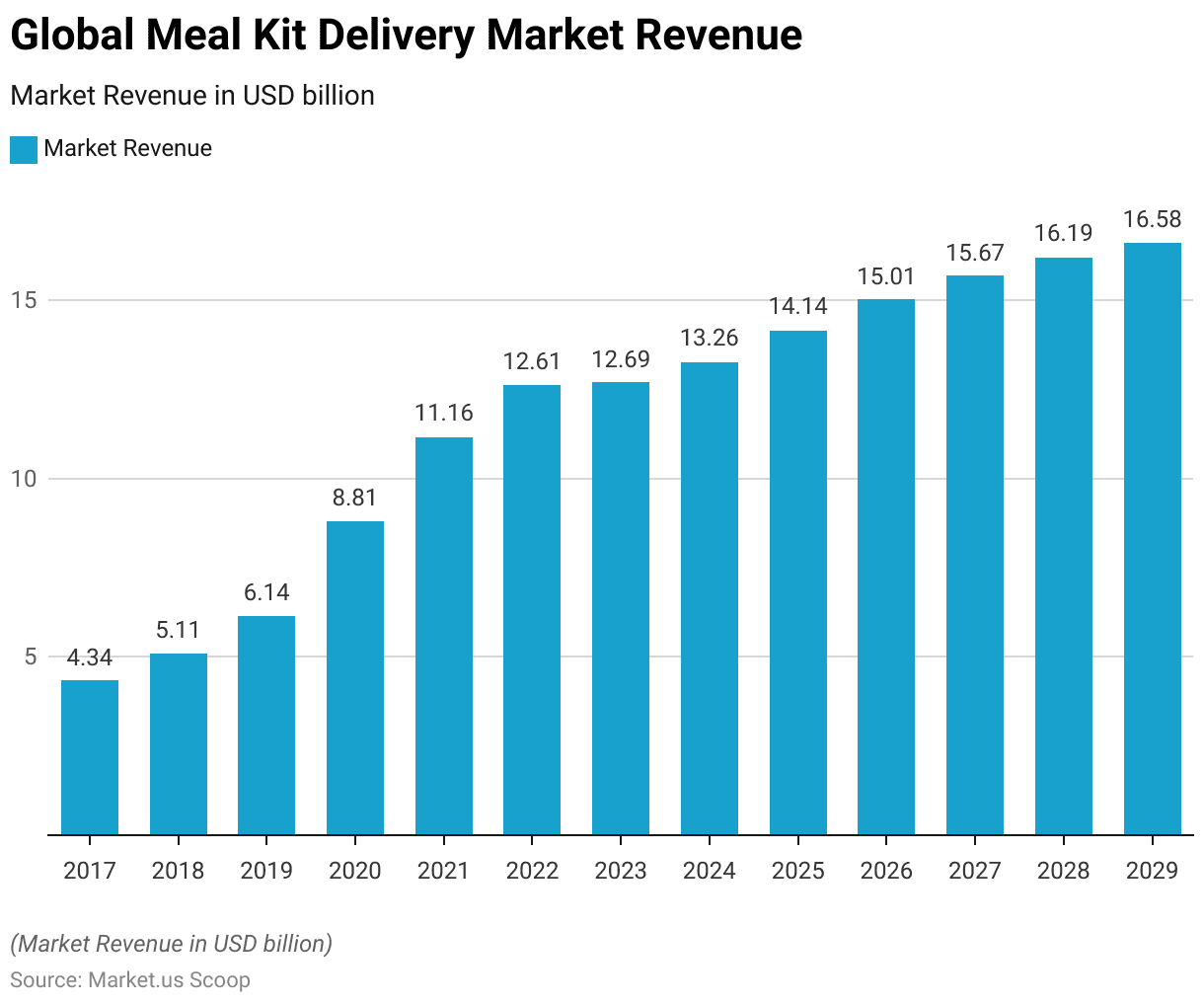
Global Meal-Kit Delivery Market Revenue Change Trends and Statistics
- The global meal kit delivery market has exhibited varying rates of revenue growth from 2018 to 2029.
- In 2018, the market experienced a 17.8% increase in revenue, which further accelerated to a 20.3% growth in 2019.
- The most significant surge occurred in 2020, with a remarkable 43.4% increase, largely driven by the heightened demand during the COVID-19 pandemic.
- In 2021, the market continued its robust growth with a 26.6% increase.
- However, the growth rate moderated to 13.1% in 2022 and further slowed to 0.6% in 2023.
- Projections for the subsequent years indicate a more stabilized growth pattern, with revenue expected to increase by 4.4% in 2024, 6.7% in 2025, and 6.1% in 2026.
- The growth rate is projected to decelerate slightly to 4.4% in 2027, 3.3% in 2028, and 2.4% in 2029.
- This trend reflects the market’s maturation and the stabilization of consumer demand following the initial rapid expansion phase.
(Source: Statista)
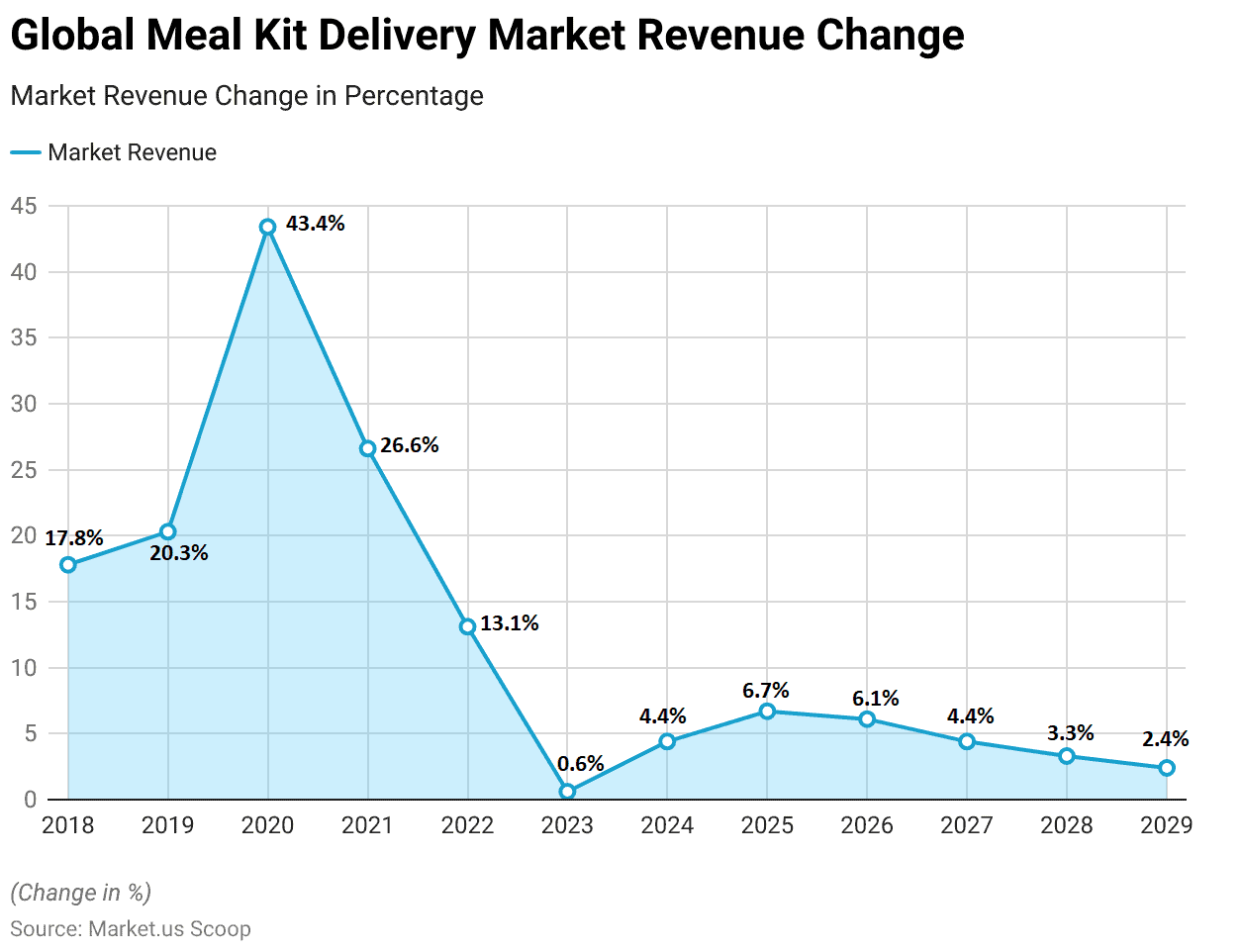
Meal-Kit Delivery Services Market Revenue – By Country Statistics
- The meal kit delivery market revenue is notably concentrated in several key countries.
- The United States leads with a substantial revenue of USD 5,645 million, reflecting its dominant position in the global market. Japan follows with USD 1,684 million, indicating strong market adoption.
- The United Kingdom also demonstrates a significant market presence with USD 1,396 million in revenue.
- Canada and Australia contribute USD 1,066 million and USD 570.40 million, respectively, showcasing their growing markets.
- Germany’s revenue stands at USD 455.60 million, while Sweden accounts for USD 341.20 million.
- In the Pacific region, New Zealand generates USD 256.10 million.
- France, Denmark, and Norway contribute USD 202.40 million, USD 174.20 million, and USD 158.70 million, respectively.
- This data highlights the geographical distribution of the meal kit delivery market, with substantial revenues concentrated in North America, Europe, and parts of the Asia-Pacific region.
(Source: Statista)
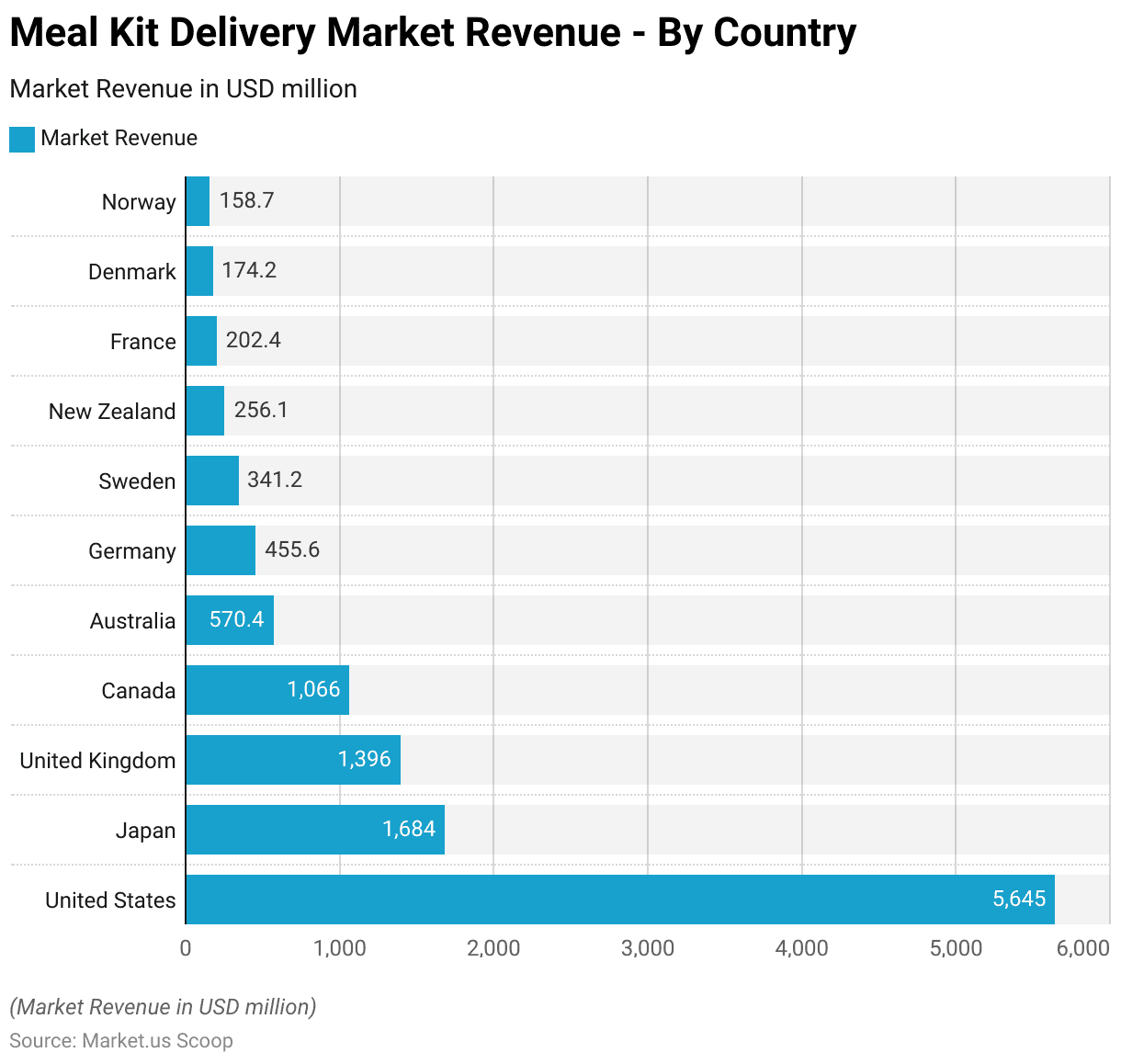
Revenue Generation Through Meat-Kit Delivery Services Statistics
- Revenue generation through meal kit delivery services has seen a steady increase in average revenue per user (ARPU) from 2017 to 2029.
- In 2017, the ARPU was USD 0.46 thousand, which rose to USD 0.48 thousand in 2018 and further to USD 0.51 thousand in 2019.
- The upward trend continued in 2020, with an ARPU of USD 0.53 thousand, and in 2021, reaching USD 0.56 thousand.
- By 2022, the ARPU had increased to USD 0.59 thousand, and further to USD 0.61 thousand in 2023.
- Projections indicate that this growth will continue, with ARPU expected to reach USD 0.63 thousand in 2024, USD 0.64 thousand in 2025, and maintaining USD 0.64 thousand in 2026.
- The ARPU is anticipated to increase further to USD 0.65 thousand in 2027 and USD 0.66 thousand in 2028 and stabilize at USD 0.66 thousand in 2029.
- This consistent rise in ARPU highlights the increasing value and spending per user within the meal kit delivery services market over the years.
(Source: Statista)
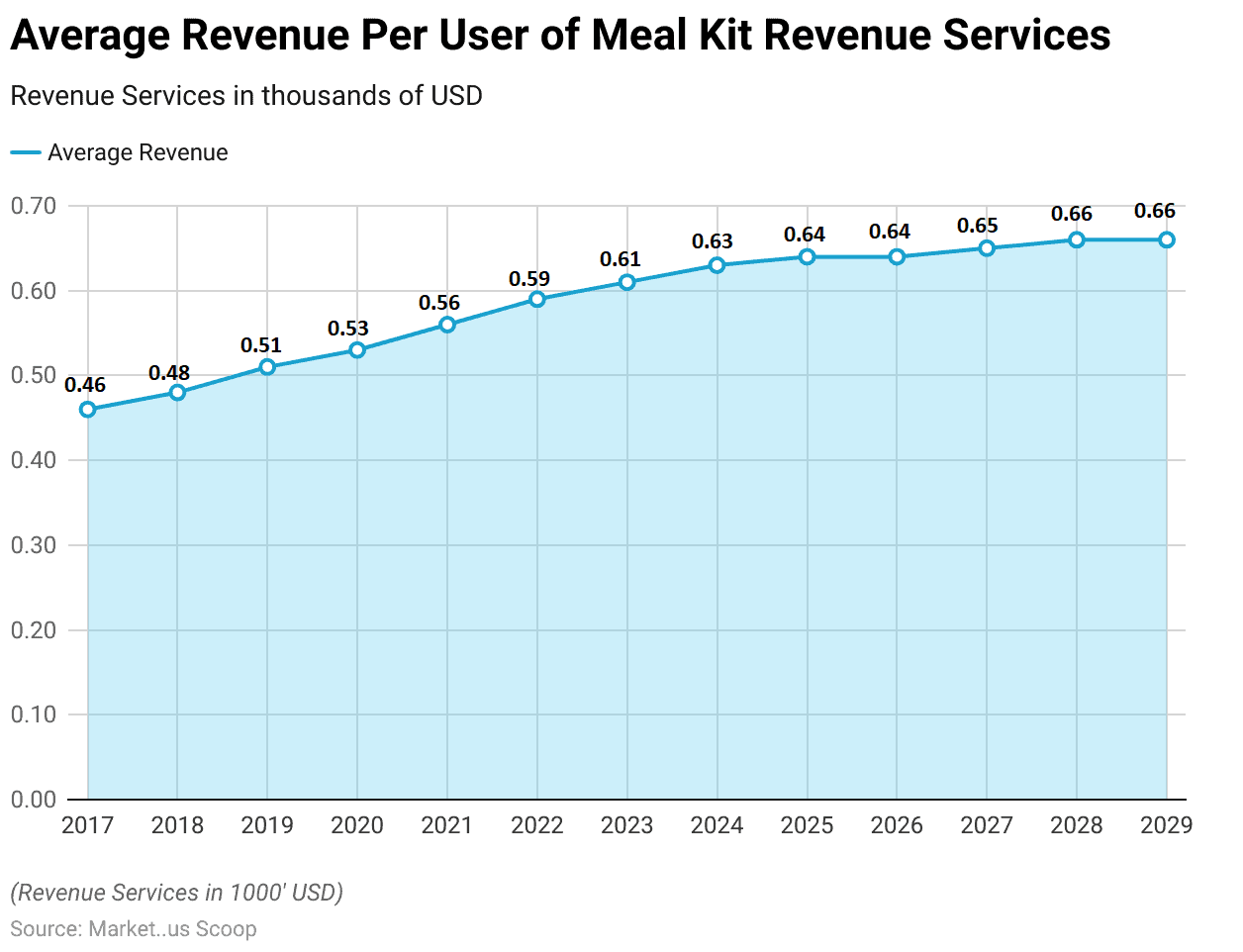
Ordering Preferences of Meat Kits Online – By Country
- The share of respondents who ordered meal kits online in the last 12 months varies significantly by country, reflecting differing levels of adoption across regions.
- In South Korea, 19% of respondents reported ordering meal kits online, the highest among the surveyed countries. India follows with 16%, indicating strong market engagement.
- The United Kingdom and China each have a 12% share of respondents ordering meal kits online.
- In the United States, 9% of respondents utilized online meal kit services, while in Spain, the share is 8%.
- France and Italy have lower adoption rates, with 6% and 5% of respondents, respectively, ordering meal kits online.
- This data underscores the varying degrees of market penetration and consumer acceptance of online meal kit delivery services across different countries.
(Source: Global Consumer Survey)
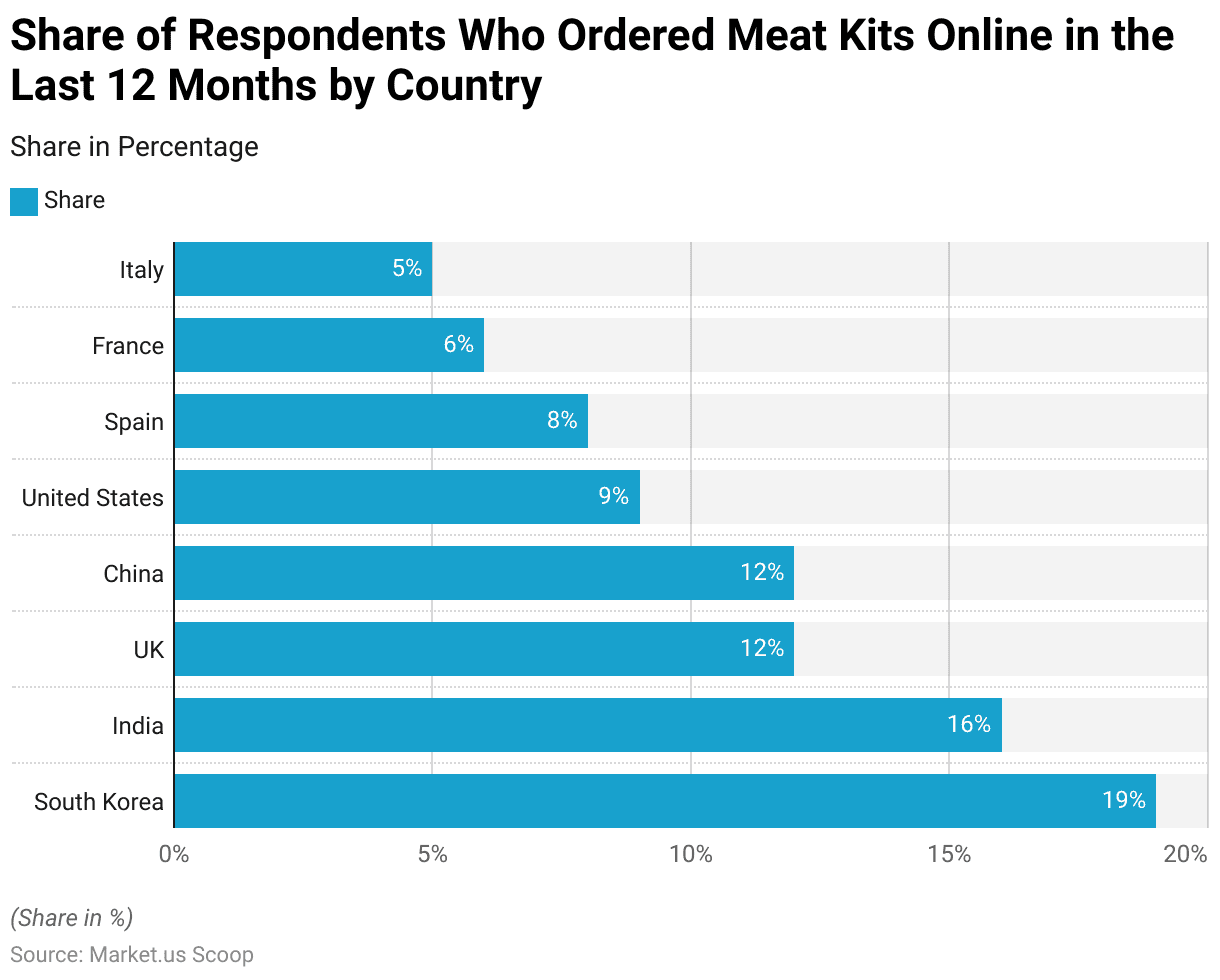
Consumer Preferences and Trends
Weekly Consumption of Meal Kit Meals
- The weekly consumption of meal kit meals among respondents shows a diverse range of usage patterns.
- A notable 33.6% of respondents reported consuming three meal kit meals per week, the highest share among the groups.
- Those consuming two meal kit meals per week accounted for 23.2% of respondents, while 22.1% reported having one meal kit meal per week.
- Additionally, 12.4% of respondents consumed five or more meal kit meals weekly, and 8.8% reported consuming four meal kit meals per week.
- This distribution highlights a significant engagement with meal kit services, with a substantial portion of users incorporating multiple meal kit meals into their weekly routines.
(Source: Medium)
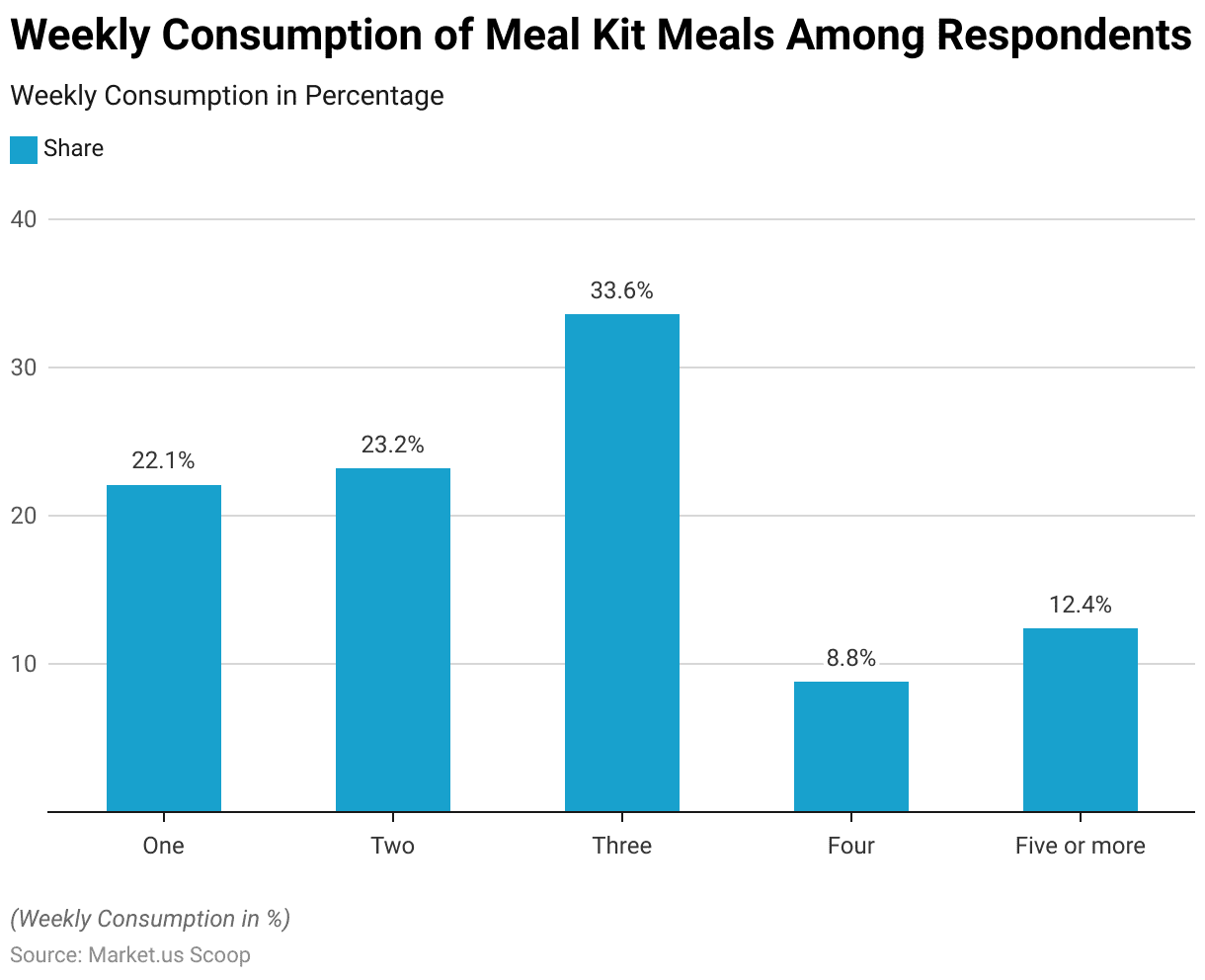
Frequency of Food Delivery Usage
- The frequency of food delivery usage among respondents in the past month reveals a diverse range of ordering habits.
- Approximately 28.2% of respondents reported using food delivery services twice, while 28.1% used them once.
- Those who ordered food three to five times constituted 27.4% of the respondents.
- Additionally, 9.3% of respondents utilized food delivery services 6 to 9 times, and 7% reported ordering food 10 or more times.
- This data illustrates the varying degrees of reliance on food delivery services, with a significant portion of respondents engaging in multiple orders within a month.
(Source: Medium)
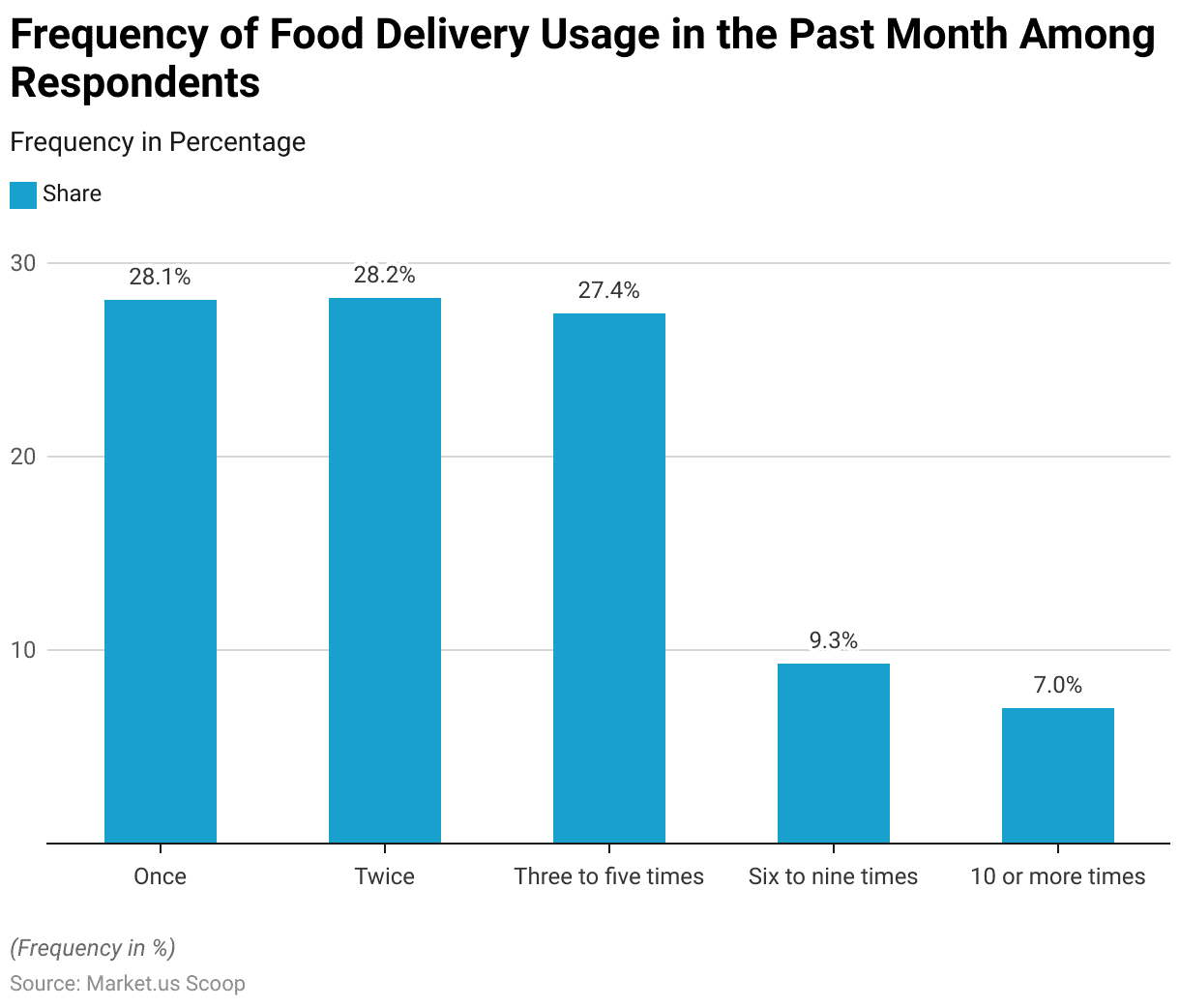
Reasons for Using Food Delivery Services
- Respondents cited several reasons for using food delivery services, reflecting diverse motivations.
- The most common reason, reported by 47.9% of respondents, was the convenience of cooking their meals.
- Additionally, 19.6% used delivery services instead of going out to eat at a restaurant, while 19.2% preferred delivery over getting takeout at a restaurant.
- Eating ready meals was the reason for 6.8% of respondents, and 6.5% stated they wouldn’t have eaten otherwise.
- This data highlights the primary factors driving the use of food delivery services, with convenience and substitution for dining out being prominent motivations.
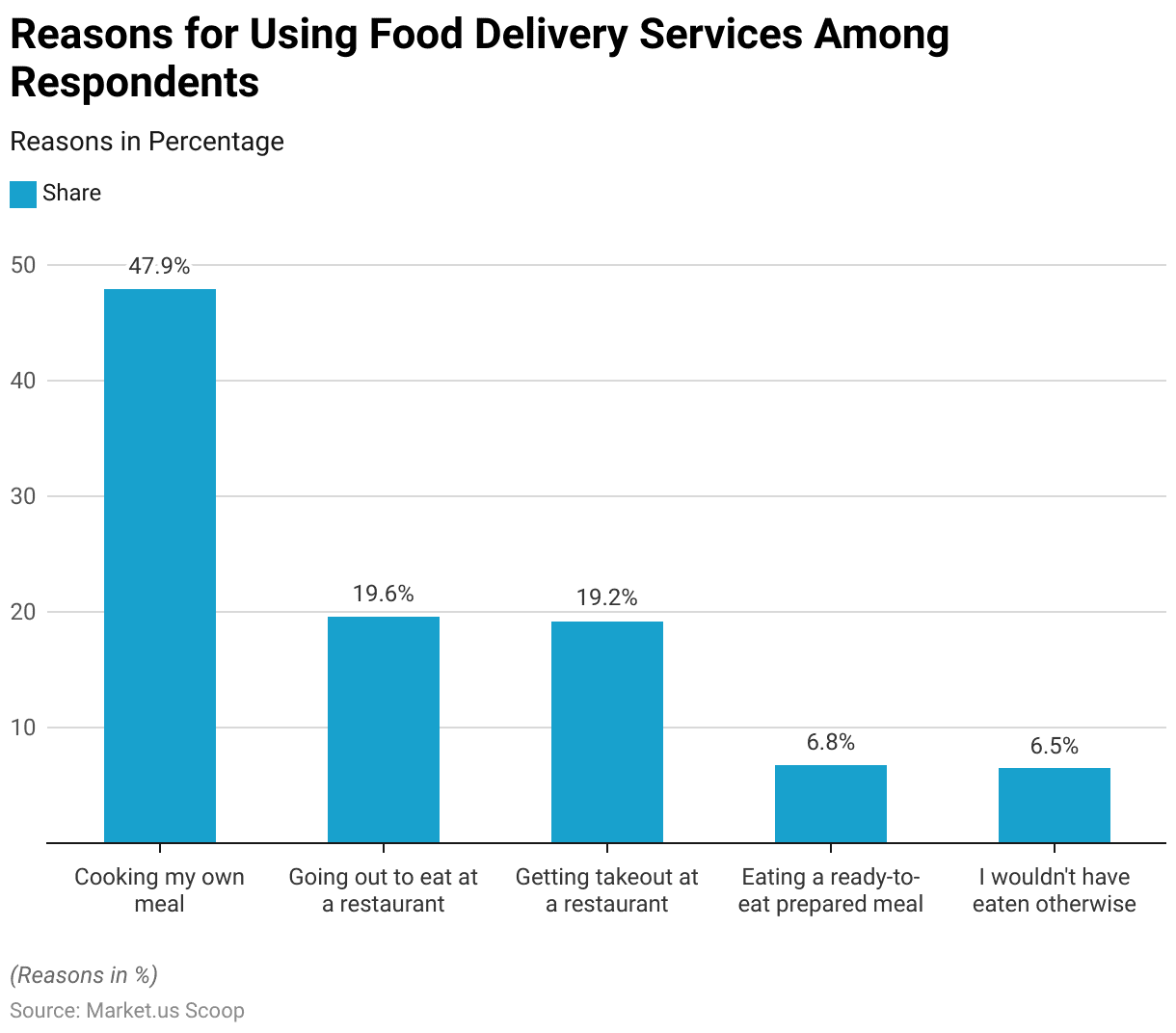
Impact of COVID-19
Usage of Delivery Services During COVID-19
- During the COVID-19 pandemic, the usage of delivery services in the United States varied significantly among different service types over the past 12 months.
- Food orders from restaurants were the most popular, with 37% of respondents utilizing this service.
- Grocery delivery services, such as AmazonFresh, were used by 35% of respondents, indicating a high demand for convenient grocery options during the pandemic.
- Meal-kit delivery services, like HelloFresh, were used by 16% of respondents, reflecting a growing interest in meal preparation convenience.
- Beverage delivery services, such as Drizly, were used by 9% of respondents.
- Notably, 38% of respondents reported not using any delivery services during this period.
- This data highlights the varied adoption of delivery services among U.S. consumers during the pandemic, with a significant portion opting for restaurant and grocery deliveries.
(Source: Statista Global Consumer Survey)
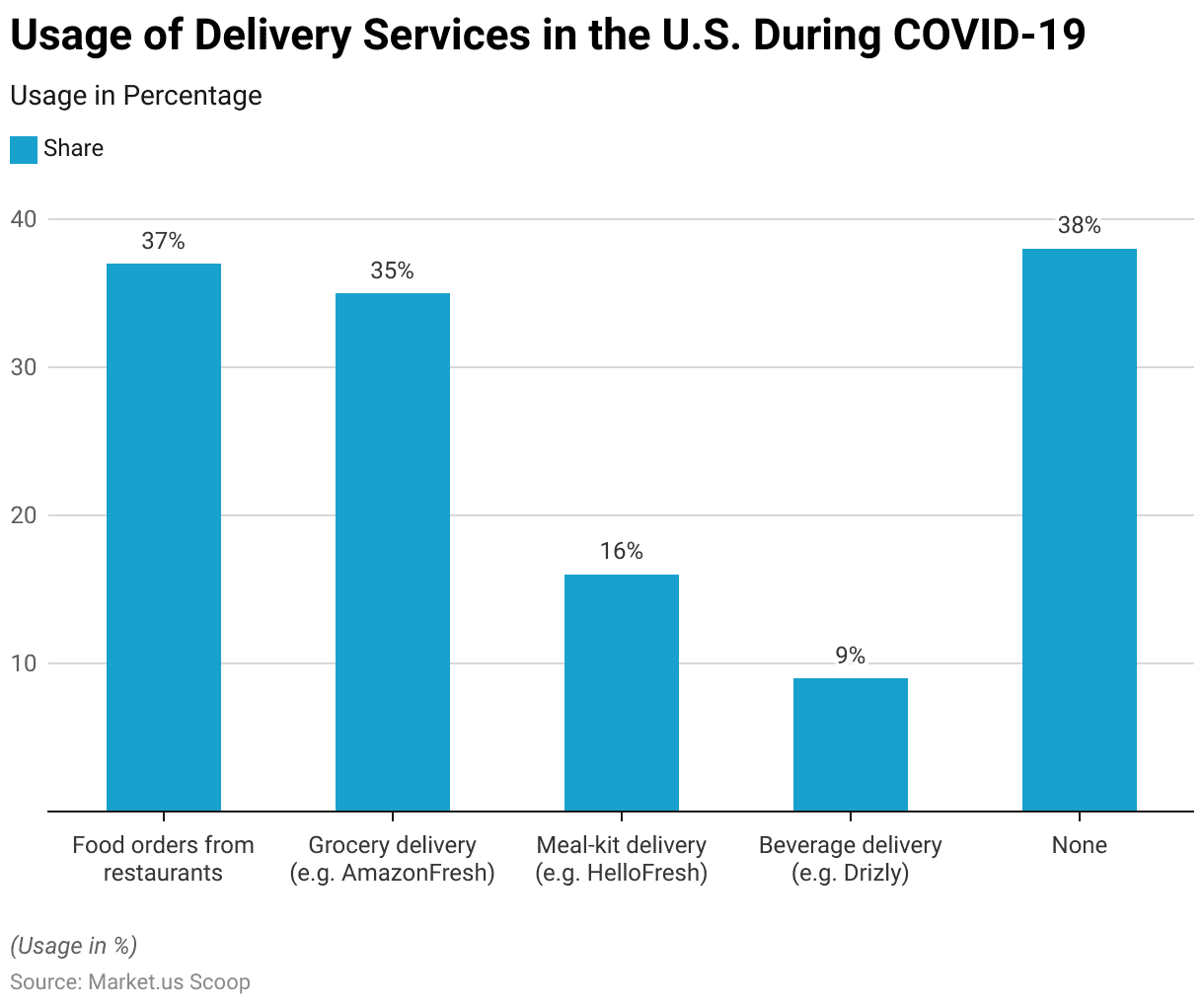
Change in Consumer Spending On Meal Kit Delivery Due to COVID-19
- In May 2020, consumer spending on meal kit delivery services in the United States exhibited varied expectations across different generations due to the coronavirus pandemic.
- Among GenZers (born 1997-2012), 15% anticipated an increase in spending, 47% expected no change, 13% predicted a decrease, and 25% were uncertain or had no opinion.
- Millennials (born 1981-1996) showed a slightly lower inclination to increase spending, with 13% expecting to spend more, 57% anticipating no change, 11% foreseeing a decrease, and 18% undecided or without an opinion.
- Gen Xers (born 1965-1980) had 9% expecting to spend more, 62% seeing no change, 11% predicting less spending, and 18% uncertain or without an opinion.
- Baby Boomers (born 1946-1964) were the least likely to increase their spending, with only 4% expecting to spend more, 60% anticipating no change, 13% predicting a decrease, and 24% unsure or without an opinion.
- This data highlights generational differences in spending expectations on meal kit delivery services during the pandemic.
(Source: Statista)
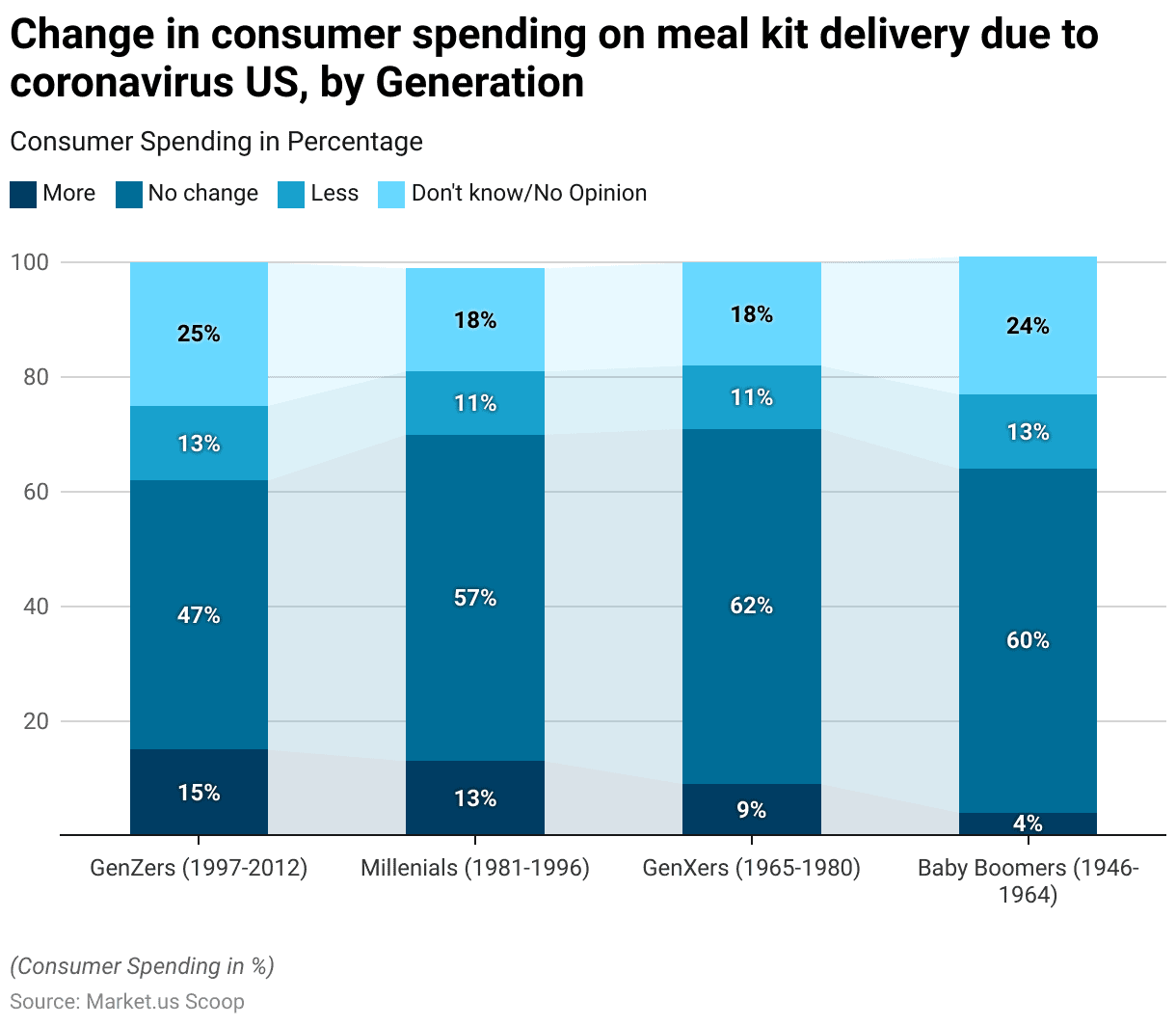
Expected Changes in Spending on Meal Kit Delivery Due to Coronavirus
- In March 2020, the expected changes in spending on meal kit delivery services in the United States due to the coronavirus pandemic revealed varied consumer expectations.
- A majority of respondents, 62%, anticipated no change in their spending on meal kit delivery services.
- Meanwhile, 10% of respondents expected to spend less, and 8% anticipated spending more.
- Additionally, 20% of respondents were uncertain about their future spending. Indicating a level of unpredictability during the early stages of the pandemic.
- This data underscores the diverse consumer outlook on meal kit delivery services amidst the evolving circumstances of the COVID-19 crisis.
(Source: Locus)
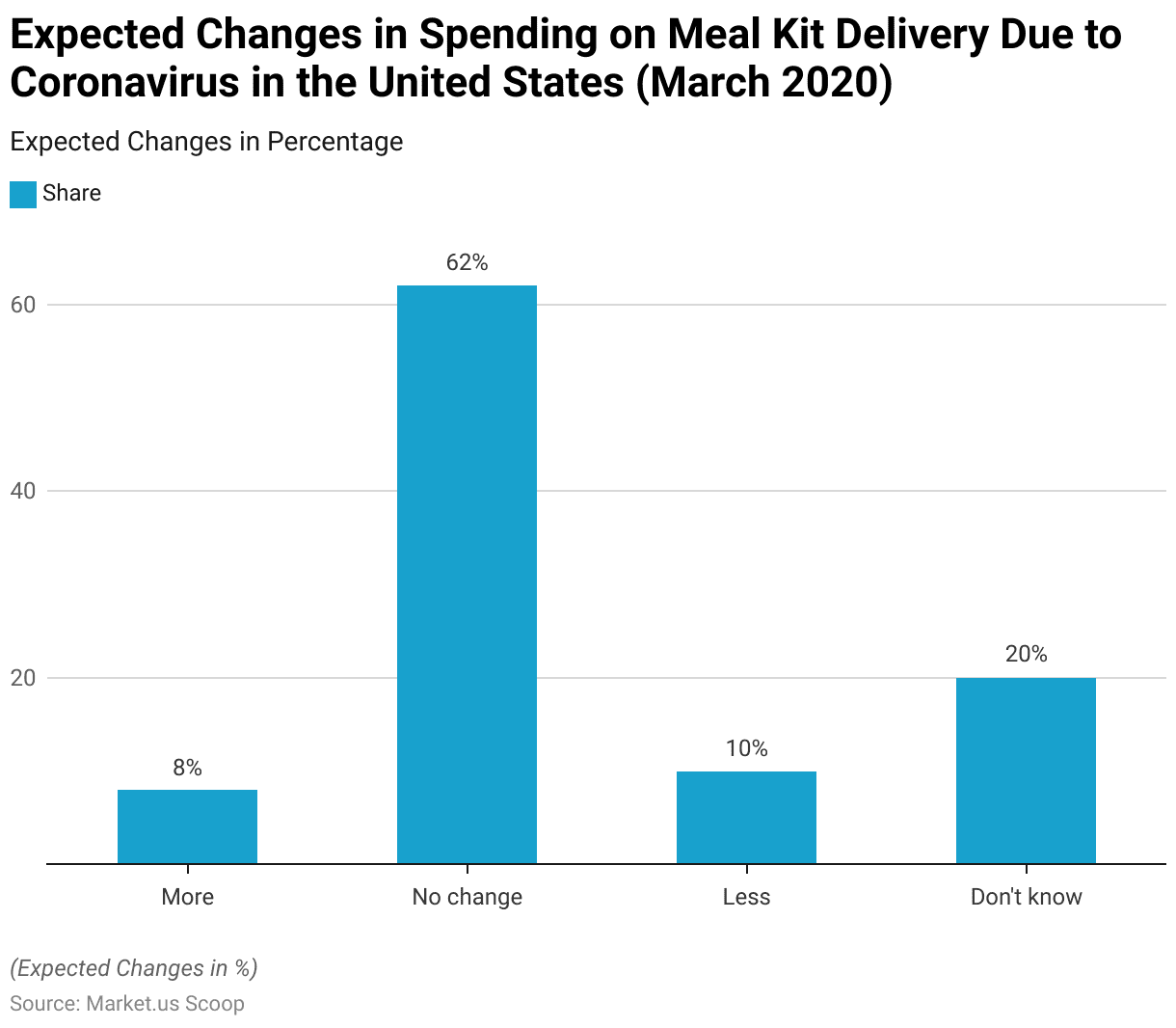
Advantages and Benefits
- In 2018, consumers in the United States identified several advantages of online meal kit delivery services.
- The primary benefit noted by 43% of respondents was convenience.
- Additionally, 37% appreciated that meal kits helped them explore new tastes. While 33% valued not having to think about what to cook.
- Time-saving was another significant advantage, cited by 32% of respondents.
- Health benefits were recognized by 27%, and 20% appreciated that meal kits taught them how to cook, saved money, and brought their family together.
- Furthermore, 15% found meal kits useful for obtaining specific items not available in stores. 14% believed they provided better quality products, and 12% valued the fresher produce.
- Lastly, 8% of respondents considered meal kits more sustainable than making individual car trips to the store.
- This data highlights the diverse range of benefits that consumers associate with online meal kit delivery services.
(Source: Statista)
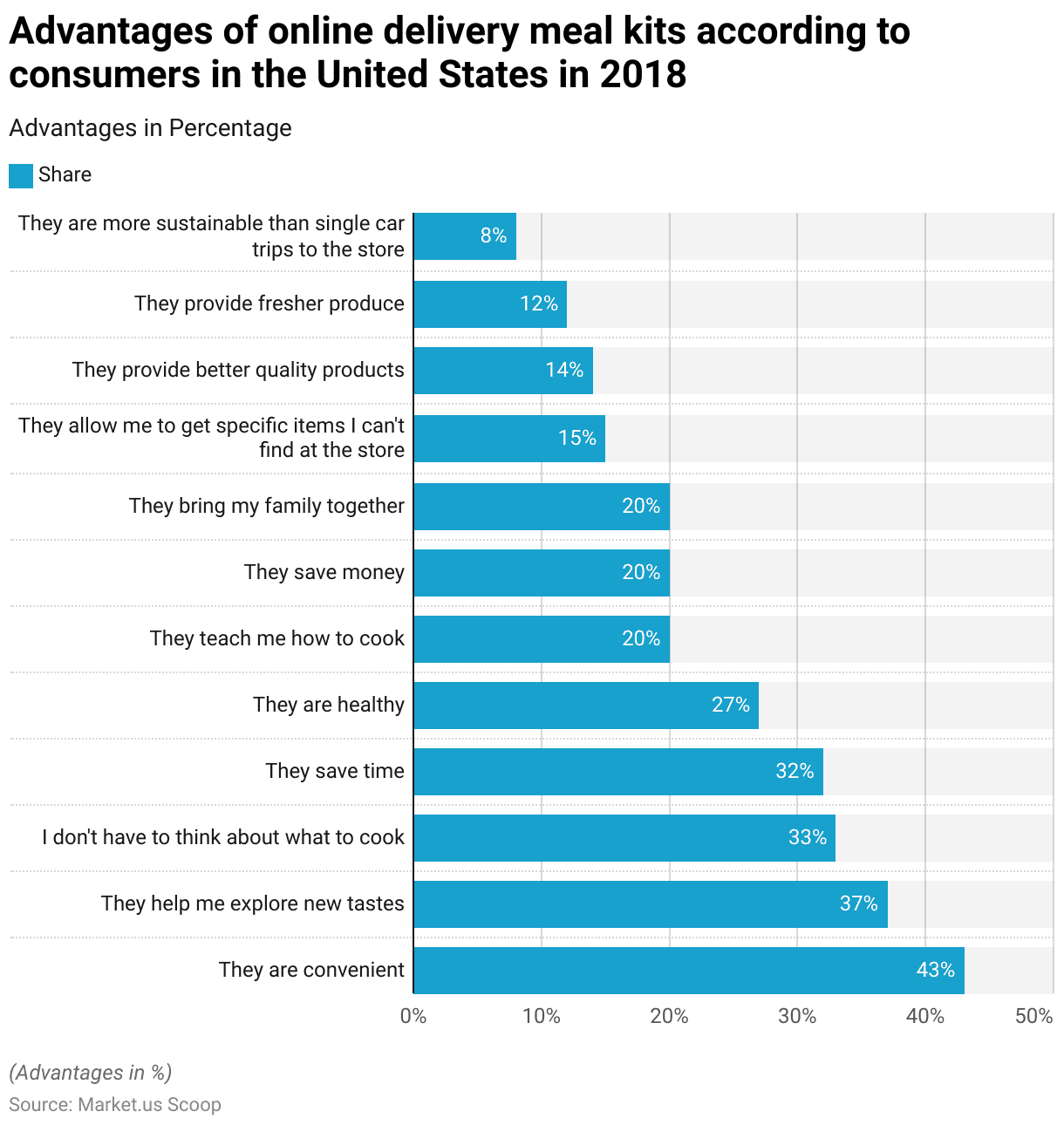
Issues and Challenges
- In Australia, the incidence of issues with meal kit delivery services varies by company.
- For Dinnerly, 50% of respondents reported never experiencing issues. while 15% encountered problems rarely, 24% sometimes, and 11% often.
- HelloFresh users reported no issues 50% of the time, with 28% rarely, 15% sometimes, and 8% often experiencing issues.
- Marley Spoon had 40% of respondents indicating no issues, 34% rarely, 17% sometimes, and 9% often.
- EveryPlate had the highest rate of trouble-free deliveries, with 57% of respondents reporting no issues, 28% rarely, 12% sometimes, and 3% often encountering problems.
- Overall, 50% of respondents across all companies reported never facing issues, 26% rarely, 16% sometimes, and 8% often.
- This data highlights that while a significant portion of users experience reliable service. There are varying levels of delivery issues among different meal kit providers in Australia.
(Source: Foodbox Mate)

Regulations for Meal Kit Delivery Services
- Regulations for meal kit delivery services vary significantly by country, reflecting different approaches to food safety and consumer protection.
- In the United States, meal kit delivery services are not universally regulated by the Food and Drug Administration (FDA).
- Some states require third-party delivery services to obtain food safety certifications. Still, overall, the regulatory framework remains fragmented and less stringent compared to traditional food service establishments like restaurants and grocery stores.
- In contrast, the European Union imposes stricter regulations on meal kit delivery services, ensuring compliance with EU food safety laws. These regulations mandate rigorous standards for food handling, storage, and transportation to prevent contamination and ensure the freshness of ingredients upon delivery.
- Additionally, countries like Germany and France have specific guidelines that meal kit companies must follow to ensure consumer safety and maintain product quality.
- Australia has similar stringent regulations, requiring meal kit delivery services to comply with national food safety standards. These include proper labeling, traceability of ingredients, and maintaining cold chain logistics to ensure food safety from the point of origin to the consumer’s doorstep.
- Overall, the regulatory landscape for meal kit delivery services is evolving. There is a notable push towards standardizing practices to enhance food safety and consumer confidence globally.
(Sources: Very Well Health, The Food Institute)
Recent Developments
Acquisitions and Mergers:
- HelloFresh acquires Factor: In early 2023, HelloFresh acquired Factor, a leading ready-to-eat meal delivery service, for $277 million. This acquisition aims to expand HelloFresh’s offerings in the health and wellness segment by integrating Factor’s prepared meal options.
- Nestlé acquires Freshly: Nestlé completed its acquisition of Freshly, a meal delivery service, for $950 million in late 2023. This merger is expected to strengthen Nestlé’s direct-to-consumer business and expand its footprint in the US market.
New Product Launches:
- Blue Apron Wellness: In mid-2023, Blue Apron launched a new wellness line, featuring meals designed to support specific health goals such as weight loss, heart health, and diabetes management. These meals are crafted with input from nutritionists and healthcare professionals.
- Sunbasket’s Vegan and Gluten-Free Options: Sunbasket introduced a new range of vegan and gluten-free meal kits in early 2024, aiming to cater to the growing demand for plant-based and allergen-free meals among health-conscious consumers.
Funding:
- EveryPlate secures $125 million: In 2023, EveryPlate, a budget-friendly meal kit service. Raised $125 million in a funding round to expand its market reach and improve its supply chain logistics. Making meal kits more accessible to a broader audience.
- Green Chef raises $100 million: Green Chef is known for its organic and keto-friendly meal kits. They secured $100 million in early 2024 to develop new product lines and enhance its sustainability initiatives, focusing on eco-friendly packaging and carbon-neutral deliveries.
Technological Advancements:
- AI and Machine Learning Integration: Meal kit companies are integrating AI and machine learning to personalize meal recommendations, optimize supply chain management, and reduce food waste by accurately predicting customer preferences and order quantities.
- Enhanced Mobile Apps: Advances in mobile app technology are providing meal kit subscribers with improved user interfaces, easy meal planning tools, and real-time delivery tracking, enhancing the overall customer experience.
Market Dynamics:
- Growth in Meal Kit Delivery Market: The global meal kit delivery market is projected to grow at a CAGR of 13.1% from 2023 to 2028, driven by the increasing demand for convenience. Healthy meal options and the rise in home cooking due to the COVID-19 pandemic.
- Increased Adoption Among Millennials and Gen Z: Meal kit services are seeing high adoption rates among Millennials and Gen Z consumers, who value convenience, variety, and the ability to try new recipes without the hassle of grocery shopping.
Regulatory and Strategic Developments:
- Sustainability Initiatives: Meal kit companies are enhancing their sustainability efforts by adopting eco-friendly packaging, reducing carbon footprints, and sourcing ingredients from sustainable farms to meet consumer demand for environmentally responsible options.
- US FDA Food Safety Modernization Act Compliance: Meal kit providers are ensuring compliance with the US FDA’s Food Safety Modernization Act, implementing strict food safety protocols and transparent labeling to maintain high standards of quality and safety.
Research and Development:
- Nutritionally Enhanced Meal Kits: R&D efforts are focusing on developing meal kits that are not only convenient but also nutritionally enhanced. Targeting specific dietary needs and health goals such as high-protein, low-carb, and anti-inflammatory diets.
- Innovative Packaging Solutions: Researchers are exploring innovative packaging solutions that are not only sustainable but also maintain the freshness and quality of ingredients during transit, improving the shelf life and reducing food waste.
Conclusion
Meal-Kit Delivery Services Statistics – The meal kit delivery services market has grown substantially. Driven by consumer demand for convenience, healthy eating, and variety.
Major players like HelloFresh and Blue Apron dominate the market, which faces regulatory challenges. Particularly in the U.S., where FDA regulation is inconsistent.
In contrast, the EU and Australia enforce stricter food safety standards. The COVID-19 pandemic increased reliance on meal kits, highlighting their role in safe, convenient dining.
As the industry evolves, it must address regulatory standardization and sustainability to maintain growth and meet consumer expectations.
FAQs
Meal kit delivery services provide pre-portioned ingredients and recipes to customers. Allowing them to prepare home-cooked meals without the hassle of meal planning and grocery shopping. Companies like HelloFresh, Blue Apron, and Marley Spoon are prominent in this market.
Customers subscribe to a meal kit service, select their meals from a weekly menu, and receive a box with all the necessary ingredients and step-by-step cooking instructions delivered to their door. Services often offer flexible subscription plans and cater to various dietary preferences.
Meal kits can be more expensive than buying groceries due to the convenience they offer. However, they can save time and reduce food waste by providing the exact portions needed for each recipe. The cost-effectiveness depends on individual shopping habits and meal choices.
While meal kit delivery services generally follow food safety standards, regulations vary by region. In the U.S., FDA regulation is inconsistent, whereas the EU and Australia enforce stricter standards. It is advisable to research a service’s safety practices and check for any recent recalls.
Meal kits offer numerous benefits, including convenience, time savings, reduced food waste, and the opportunity to try new recipes and ingredients. They also cater to specific dietary needs and can promote healthier eating habits.
Discuss your needs with our analyst
Please share your requirements with more details so our analyst can check if they can solve your problem(s)



